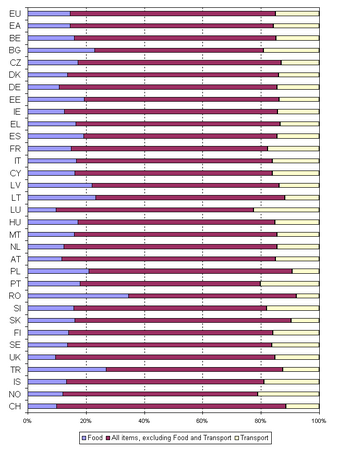Archive:HICP - household consumption patterns
The consumption patterns of households determine the relative importance (weight) of household monetary expenditure that is attached to each of the categories of goods and services covered by the Harmonized index of consumer prices (HICP). The impact on the all-items index of any price change is proportional to the size of the corresponding weight. There is no uniform basket applying to all Member States. The structure of the weights may vary considerably between the HICPs for individual Member States as well as between the HICP for an individual Member State and the average weighting structure according to the European Union (EU) or the euro area. HICP item weights are updated each year.
Within the European aggregates (euro area and EU), the weight of a Member State in the euro area or in the EU is its share of household final monetary consumption expenditure (HFMCE) in the totals.
Main statistical findings
Consumption patterns in Member States
In 2008, the three categories food, transport and housing, each accounting for around 15% of consumption expenditure, were those with the largest weights in both country groups: the EU and the euro area. A weight of around one tenth is attached to recreation and culture, though it is a little more important for the whole EU than for the euro area. Only just below are the weights for restaurants and hotels, which again are slightly higher for the EU. Within the national HICPs the weight for food varies between 11–12% (the United Kingdom, Luxembourg, Germany) and 37% (Romania). The share for transport in HFMCE ranges from 8–10% (Romania, Poland, Slovakia) to 19–23% (Bulgaria, Portugal and Luxembourg). Consumption expenditure on recreation and culture ranges from 5% (Bulgaria, Portugal, Romania, and Greece) to 15% (the United Kingdom). The weight for housing ranges from 8-9% (Malta, Cyprus, Greece and Luxembourg) to 22–23% (Slovakia and Germany). In the housing category, it should be noted that HICPs reflect only monetary expenditure; unlike national accounts or household budget surveys, they do not cover services provided by owner occupied dwellings. This means that countries in which a larger proportion of the population lives in rented dwellings tend to have a larger weight for housing than countries in which a larger proportion of households live in their own dwellings.
Importance of Member States' consumption expenditure
The coverage og the HICP is delimited by HFMCE, and so concerns that part of the final consumption expenditure which is: - by households, irrespective of their nationality or residence status, - in monetary trnasactions, - on the economic territory of the EU Member State, - on goods and services that are used for the direct satisfaction of individual needs or wants, - in one or both of the time periods being compared.
The prices used in the HICP should be the prices paid by households to purchase individual goods and services in monetary transactions. The purchaser's price for the products that the purchaser actually pays at the time of purchase.
The weight of the HICP are the aggregate expenditures by households on any set of goods and services covered by the HICP, expressed as a proportion of the total expenditure on all goods and services within the coverage of the HICP.
The HICPs are classified according to the 4-digit categories and sub-categories of the COICOP/HICP.
The concept of HFMCE not only specifies the coverage, the prices and the weights for the HICP, but also establishes a link between HICPs and ESA95 that has proved useful analysts and policy-makers. HICP definitions follow ESA95 wherever possible and when to do so it is consistent with the aims and uses of the HICp. That said, there are some differences between the coverage of the HICPs and that of household final consumption expenditure (HFCE) as defined by national accounts, in particular the treatment of owner-occupied housing.
The country weights used in 2008 are based on national accounts data for 2006 updated to December 2007 prices. For the euro area, weights in national currencies are converted into euro using the irrevocably locked exchange rates. For the EU, weights in national currencies are converted into purchasing power standards. The weight of the euro area reflects its share in the EU total.

